Showing posts with label tree fort. Show all posts
Showing posts with label tree fort. Show all posts
12.2.11
Locality 65 (Jacksonville, Florida) Throw away the ladder
"My propositions serve as elucidations in the following way: anyone who understands them eventually recognizes them as nonsensical, when he has used them -- as steps -- to climb up beyond them. (He must, so to speak, throw away the ladder after he has climbed up it.)"
Ludwig Wittgenstein, Tractatus Logico Philosophicus, 1921.
Photo: Mike Lesnick
Etiketter:
Florida,
Jacksonville,
Ludwig Wittgenstein,
Mike Lesnick,
tree fort
28.1.11
Locality 62 (Rossekniben) Festung Norwegen
Festung Norwegen, the perimeter of the Third Reich against an allied attack which the Nazi leadership assumed would occur in Norway. Remote pristine coastal landscapes scattered with ruins of defence and fortification systems, coastal artillery, anti-aircraft batteries.

At Rossekniben in Grimstad, an inaccessible observation post was installed to provide a panorama view of the sea, guarded by artilleries until the end of the war. Artillery positions were carefully observed and reported by the local XU group.

Our own underground intelligence agents reveal that construction of fortresses has once again commenced in the area. Just beneath the observation post at Rossekniben, a small wooden fort partly hidden by the thick forest canopy has been registered. The purpose of the fort is as of yet uncertain and at this point may be labeled X for Unknown.



At Rossekniben in Grimstad, an inaccessible observation post was installed to provide a panorama view of the sea, guarded by artilleries until the end of the war. Artillery positions were carefully observed and reported by the local XU group.

Our own underground intelligence agents reveal that construction of fortresses has once again commenced in the area. Just beneath the observation post at Rossekniben, a small wooden fort partly hidden by the thick forest canopy has been registered. The purpose of the fort is as of yet uncertain and at this point may be labeled X for Unknown.


Etiketter:
Festung Norwegen,
Grimstad,
Rossekniben,
tree fort,
world war 2,
XU
29.4.10
Locality 61 (Fevik, Norway) Noah's Ark


And God said to Noah, "I have determined to make an end of all flesh, for the earth is filled with violence through them. Behold, I will destroy them with the earth. 14Make yourself an ark of gopher wood. Make rooms in the ark, and cover it inside and out with pitch. 15This is how you are to make it: the length of the ark 300 cubits, its breadth 50 cubits, and its height 30 cubits. 16Make a roof for the ark, and finish it to a cubit above, and set the door of the ark in its side. Make it with lower, second, and third decks. 17

And of every living thing of all flesh, you shall bring two of every sort into the ark to keep them alive with you. They shall be male and female. 20Of the birds according to their kinds, and of the animals according to their kinds, of every creeping thing of the ground, according to its kind, two of every sort shall come in to you to keep them alive.


22 Noah did this; he did all that God commanded him.
Genesis 6.
15.3.10
Locality 60 (Fevik, Norway) Spirit of youth
28.2.10
Locality 59 (Goetheturm, Germany) Winter Solitude
 Winter solitude--
Winter solitude--in a world of one color
the sound of wind.
Matsuo Basho (1644-1694).
Photo: stbeck
14.2.10
Locality 58: (Arcadia, Argentina) To Make a Dadaist Poem
 TO MAKE A DADAIST POEM
TO MAKE A DADAIST POEMTake a newspaper.
Take some scissors.
Choose from this paper an article of the length you want to make your poem.
Cut out the article.
Next carefully cut out each of the words that makes up this article and put them all in a bag.
Shake Gently.
Next take out each cutting one after the other.
Copy conscientiously in the order in which they left the bag.
The poem will resemble you.
Tristan Tzara, Dada Manifesto on Free Love and Bitter Love (1920)
Photo: Cinco Sauses (Julian Gatto)
Etiketter:
Arcadia,
Argentina,
dada,
Julian Gatto,
tree fort,
Tristan Tzara
29.12.09
26.11.09
Locality 54 (Ontario, Canada) Rememberance of Things Past

I feel that there is much to be said for the Celtic belief that the souls of those whom we have lost are held captive in some inferior being, in an animal, in a plant, in some inanimate object, and so effectively lost to us until the day (which to many never comes) when we happen to pass by the tree or to obtain possession of the object which forms their prison. Then they start and tremble, they call us by our name, and as soon as we have recognised their voice the spell is broken. We have delivered them: they have overcome death and return to share our life.
And so it is with our own past. It is a labour in vain to attempt to recapture it: all the efforts of our intellect must prove futile. The past is hidden somewhere outside the realm, beyond the reach of intellect, in some material object (in the sensation which that material object will give us) which we do not suspect. And as for that object, it depends on chance whether we come upon it or not before we ourselves must die.
Marcel Proust, Rememberance of Things Past, 1913.
Photo: Kronix
31.10.09
Locality 47-52: Merz
 Hamburg-Finkenwerder, Germany. Tdietmut
Hamburg-Finkenwerder, Germany. Tdietmut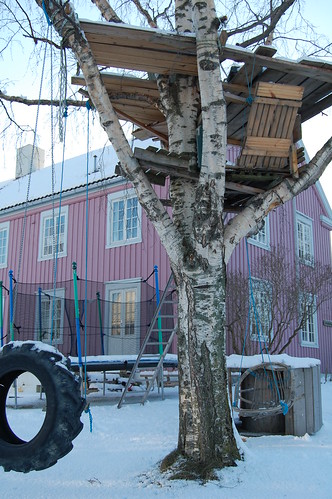 Rotvoll, Norway. Astridsol
Rotvoll, Norway. Astridsol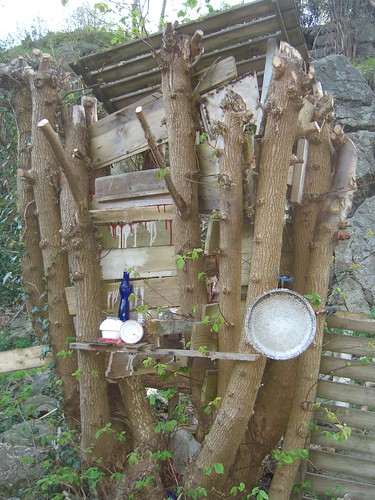 North Sea Cycle Route. Kalevkevad
North Sea Cycle Route. Kalevkevad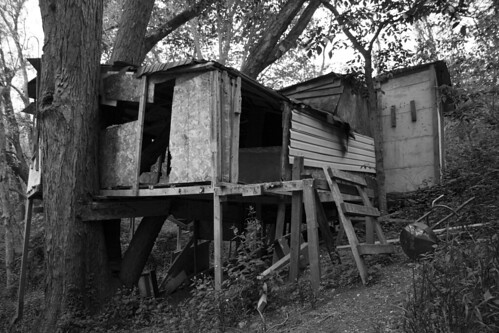
Central Illnois, US. Larryt135
 Merzbau, Hannover 1933. Kurt Schwitters.
Merzbau, Hannover 1933. Kurt Schwitters.
Etiketter:
Astridsol,
dada,
hamburg,
hannover,
kalevkevad,
Kurt Schwitters,
larryt135,
Merz,
merzbau,
north sea cycle route,
rotvoll,
tdietmut,
tree fort,
westport
26.10.09
Locality 46 (Little Falls, NY) Keeping out of trouble

Explorer Bartzilla reports from an expedition into his own youth:
"Whoever nailed that ladder into the side of the tree must have done it long ago since those slats of wood couldn't support anything these days. This wasn't our original ladder into the fort. Ours was on the other side and a bit more accessible.
The fire pit we had dug and circled with rocks was also washed away, as were the log benches we had put around it. I'm tellin' ya, we went all out on this project. Plus, for the most part, it kept us out of trouble on summer vacations, even if we might have been up to no good up there.
One afternoon of construction, I was blowing off some firecrackers and we saw a policeman doing his commando thing with his shotgun up to the fort. He knew what we were up to and actually just told us to knock it off with the firecrackers and then proceeded to admire our handy work and give us his history of the tree fort that his friends had built in this tree."
Etiketter:
Bartzilla,
Little Falls NY,
nostalgia,
police,
tree fort
23.10.09
Locality 44 (Brentwood, TN): I sit and look
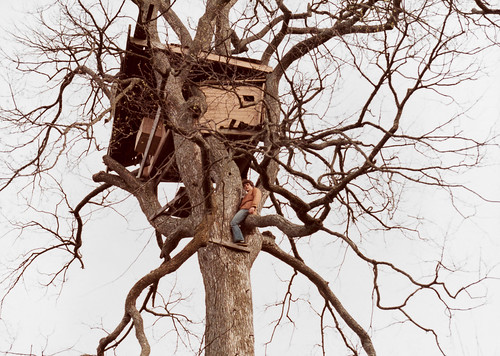 I sit and look
I sit and look I sit and look out upon all the sorrows of the world, and upon all
oppression and shame;
I hear secret convulsive sobs from young men, at anguish with
themselves, remorseful after deeds done;
I see, in low life, the mother misused by her children, dying,
neglected, gaunt, desperate;
I see the wife misused by her husband--I see the treacherous seducer
of young women;
I mark the ranklings of jealousy and unrequited love, attempted to be
hid--I see these sights on the earth;
I see the workings of battle, pestilence, tyranny--I see martyrs and
prisoners;
I observe a famine at sea--I observe the sailors casting lots who
shall be kill'd, to preserve the lives of the rest;
I observe the slights and degradations cast by arrogant persons upon
laborers, the poor, and upon negroes, and the like;
All these--All the meanness and agony without end, I sitting, look out
upon,
See, hear, and am silent.
Walt Whitman, Leaves of Grass - 1871 ed.
Photo: Majtek862
Etiketter:
brentwood,
I sit and look,
leaves of grass,
majtek862,
tree fort,
Walt Whitman
19.10.09
Locality 43: A poem lovely as a tree
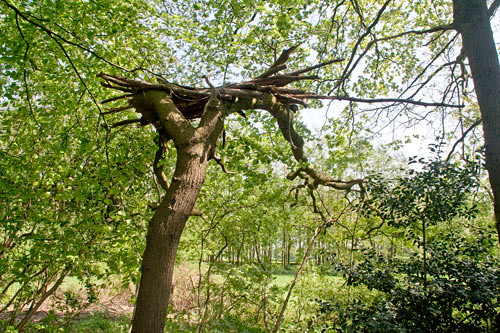 I think that I shall never see
I think that I shall never seeA poem lovely as a tree
-Joyce Kilmer, Trees, 1913
Photo: Lex van de Oudeweetering
Etiketter:
Joyce Kilmer,
lexillustrator,
tree fort,
Trees
30.9.09
The unknown

: We don´t know how we got here,
or where we are.We do not know who was here before us,
or where they are now.
We dont even know if they were the ones
that made thís scene.
All we know is that this "home" is very
much alive, and i think we just moved in.
15.9.09
30.7.09
Locality 39 (Aigle, Switzerland) Unintended Installation
 In the forest, near "Aigle", Switzerland, artist and explorer Nicolas Geiser came across this kid hut on slim tree stilts, reachable by a long ladder made of two poles with plank steps. The hut is constructed so that no two boards are alike, nor of the same length. And the "door" is actually a rug. Creativity is the mother of invention.
In the forest, near "Aigle", Switzerland, artist and explorer Nicolas Geiser came across this kid hut on slim tree stilts, reachable by a long ladder made of two poles with plank steps. The hut is constructed so that no two boards are alike, nor of the same length. And the "door" is actually a rug. Creativity is the mother of invention.
Etiketter:
aigle,
installation,
nicolas geiser,
tree fort
9.7.09
Locality 38 (Arendal) Ascent at Paradise Bay
 Using our expedition boat, a GH 14 with a Yamaha 9,9 HP outboard motor, we are now able to navigate into unexplored bays and islets in the archipelago outside the South Coast of Norway. At Paradise Bay on the small island Havsøy outside of Arendal, a large Ash invited itself to be explored. Somebody had mounted a small swing from one of the branches. At the top of the tree we thought we could discern a small tree hut, but could not be sure from our position on the ground.
Using our expedition boat, a GH 14 with a Yamaha 9,9 HP outboard motor, we are now able to navigate into unexplored bays and islets in the archipelago outside the South Coast of Norway. At Paradise Bay on the small island Havsøy outside of Arendal, a large Ash invited itself to be explored. Somebody had mounted a small swing from one of the branches. At the top of the tree we thought we could discern a small tree hut, but could not be sure from our position on the ground. Choosing a moment when no-one seemed near, we leapt sinuous and catlike, into the lower branches of the forest giant. Silently we climbed to a great height until we found a point where we could look through a leafy opening upon the scene beneath us.
Choosing a moment when no-one seemed near, we leapt sinuous and catlike, into the lower branches of the forest giant. Silently we climbed to a great height until we found a point where we could look through a leafy opening upon the scene beneath us.

 We had now ascended to the structure we could discern from the ground, and from this angle we realized that it was more of a look-out tower at the top of the forest canopy than a proper hut. A floor, but no walls or roof, the structure was nevertheless sturdily built, and the bent spikes told the tale about the young builders. How on earth they had managed to get up there remained a mystery until we found remains of past ropes that in the past must have made the ascent at Paradise Bay a breeze.
We had now ascended to the structure we could discern from the ground, and from this angle we realized that it was more of a look-out tower at the top of the forest canopy than a proper hut. A floor, but no walls or roof, the structure was nevertheless sturdily built, and the bent spikes told the tale about the young builders. How on earth they had managed to get up there remained a mystery until we found remains of past ropes that in the past must have made the ascent at Paradise Bay a breeze.
Etiketter:
arendal,
ash,
Edgar Rice Burroughs,
gh 14,
Havsøy,
paradisbukta,
Tarzan,
tree fort
18.5.09
Locality 36 (Martinsburg, West Virginia) Simple Living
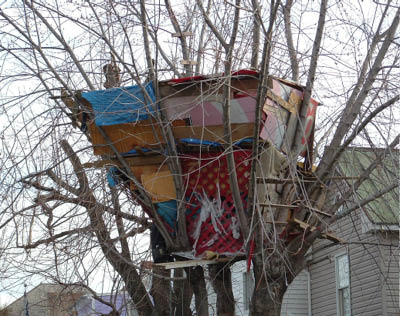
Explorer Dr. Boden managed to document this tree construction in Martinsburg, West Virginia before the city made the young constructor James demolish the site on claims it was an "eye sore". But with this more substantial shelter about him, he had made some progress toward settling in the world. This frame, so slightly clad, was a sort of crystallization around him, and reacted on the builder. It was suggestive, somewhat as a picture in outlines. He did not need to go outdoors to take the air, for the atmosphere within had lost none of its freshness. "An abode without birds is like a meat without seasoning".
Etiketter:
dr.boden,
Henry David Thoreau,
martinsburg,
simple living,
tree fort,
Walden,
west virginia
4.5.09
Det norske huset

Frode Grytten and photographer Jens Hauge have been on extensive kid hut expeditions and present their reports in the book "Det norske huset". According to Dagbladet, the starting point for the book project was close to 70 b/w photographies of Norwegian kid huts, documented by Hauge across the last 20 years, everything from small shacks in the trees, sheet metal huts and snow castles to strange tunnelways, crooked verandas and more elaborate constructions resembling art installations. . .
Etiketter:
det norske huset,
frode grytten,
jens hauge,
tree fort
13.4.09
Locality 27-35 (Fevik) A Survey

We now publish the preliminary results of the survey conducted within the Søm-Ruagerkilen Nature Reserve at Fevik, Norway. The area only became protected in 2006, and contains a birch forest housing a wealth of biological diversity, as well as the Ruagerkilen lagoon sheltered from the open sea and containing a number of sea birds.
 The survey discovered as many as 9 different localities within the area. The density of huts was particularly striking in the immediate proximity to the lagoon itself, making it likely that the same constructors were responsible for most of these huts. All of these were basic tree huts at various stages of completion, constructed mainly from wooden boards.
The survey discovered as many as 9 different localities within the area. The density of huts was particularly striking in the immediate proximity to the lagoon itself, making it likely that the same constructors were responsible for most of these huts. All of these were basic tree huts at various stages of completion, constructed mainly from wooden boards.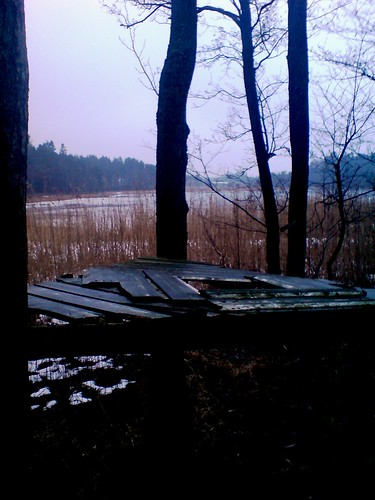

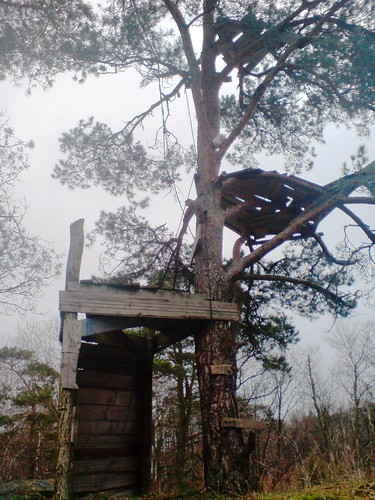
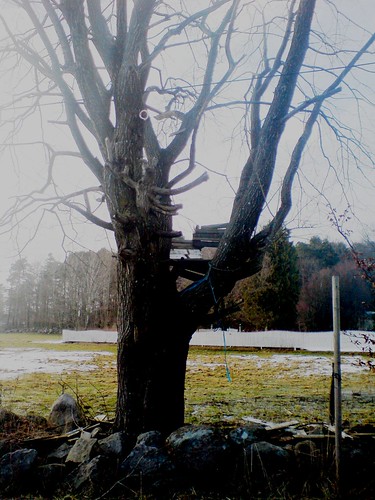
However, there were also two other localities that displayed a completely different culture, notably locality 27, and 32. The former was in fact the most concealed site, located only 20-25 metres from a dirt road at the outskirts of the forest, and the last to be discovered. The site consisted of a sort of rough A-shape shelter built from tree branches and some additional tarpauling. The attempt at concealing the hut makes sense given that it was actually located within the protected forest, making it illegal. However, all of these localities were actually within the protected area.

The only other hut bearing any likeness to loc. 27, was loc. 32, which was found within the protected forest itself. This was also constructed in the manner of a shelter, although missing a full cover. An old hand saw was found at the site, perhaps suggesting that the hut was of considerable age and may have been built before the area became protected. However, it should be noted that both these latter localities were ecologically built, using rope and branches and carefully blending in with the landscape, on the border of making them invisible.
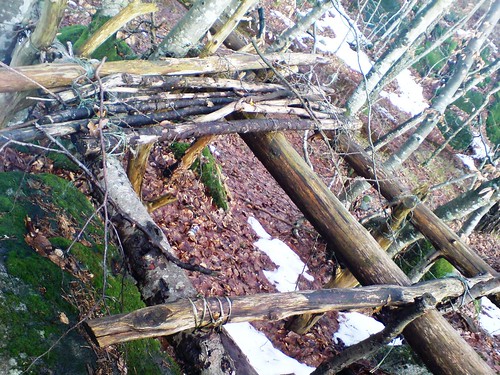
Etiketter:
fevik,
søm-ruagerkilen naturreservat,
survey,
tree fort
7.4.09
Locality 26 (Basel, Switzerland) The Lilliputians are coming
 Intrepid explorer Gulliver Lorpailleur discovered this miniature construction 3/4 up a street lamp in Basel. Obviously the constructors must be illegal immigrants from a remote nation of the world. "Hekhinah Degul" indeed.
Intrepid explorer Gulliver Lorpailleur discovered this miniature construction 3/4 up a street lamp in Basel. Obviously the constructors must be illegal immigrants from a remote nation of the world. "Hekhinah Degul" indeed.
Etiketter:
basel,
gulliver's travels,
jonathan swift,
miniature,
tree fort
Subscribe to:
Posts (Atom)




